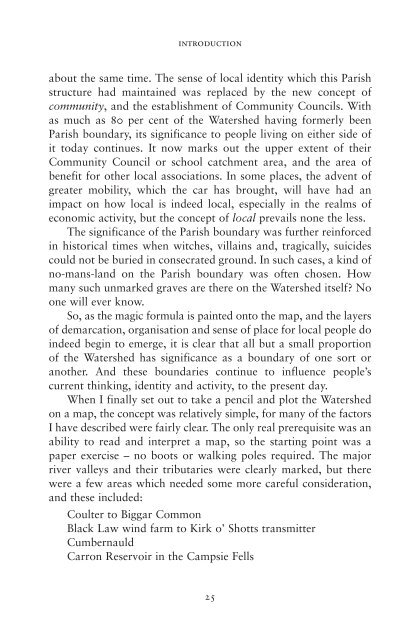Ribbon of Wilderness by Peter Wright sampler
If you’ve bagged the Munros, done the Caledonian Challenge and walked the West Highland Way, this is your next conquest. The Watershed of Scotland is a line that separates east from west; that divides those river basin areas which drain towards the North Sea from those which flow west into the Atlantic Ocean on the other. It’s a line that meanders from Peel Fell on the English border all the way to the top at Duncansby Head, near John O’ Groats – over 745 miles, through almost every kind of terrain. The Watershed follows the high ground, and offers wide vistas down major river valleys, towards towns and communities, into the heartlands of Scotland. Walk the Watershed in eight weeks Tackle short sections over a weekend 7 route maps Over 30 colour photographs Ribbon of Wildness provides a vivid introduction to this geographic and landscape feature, which has hitherto been largely unknown. The rock, bog, forest, moor and mountain are all testament to the Watershed’s richly varied natural state. The evolving kaleidoscope of changing vistas, wide panoramas, ever-present wildlife, and the vagaries of the weather, are delightfully described on this great journey of discovery.
If you’ve bagged the Munros, done the Caledonian Challenge and walked the West Highland Way, this is your next conquest.
The Watershed of Scotland is a line that separates east from west; that divides those river basin areas which drain towards the North Sea from those which flow west into the Atlantic Ocean on the other. It’s a line that meanders from Peel Fell on the English border all the way to the top at Duncansby Head, near John O’ Groats – over 745 miles, through almost every kind of terrain. The Watershed follows the high ground, and offers wide vistas down major river valleys, towards towns and communities, into the heartlands of Scotland.
Walk the Watershed in eight weeks
Tackle short sections over a weekend
7 route maps
Over 30 colour photographs
Ribbon of Wildness provides a vivid introduction to this geographic and landscape feature, which has hitherto been largely unknown. The rock, bog, forest, moor and mountain are all testament to the Watershed’s richly varied natural state. The evolving kaleidoscope of changing vistas, wide panoramas, ever-present wildlife, and the vagaries of the weather, are delightfully described on this great journey of discovery.
Create successful ePaper yourself
Turn your PDF publications into a flip-book with our unique Google optimized e-Paper software.
<strong>Ribbon</strong>s <strong>of</strong> Wildness_2016_Layout 1 24/05/2016 19:26 Page 25<br />
introduction<br />
about the same time. The sense <strong>of</strong> local identity which this Parish<br />
structure had maintained was replaced <strong>by</strong> the new concept <strong>of</strong><br />
community, and the establishment <strong>of</strong> Community Councils. With<br />
as much as 80 per cent <strong>of</strong> the Watershed having formerly been<br />
Parish boundary, its significance to people living on either side <strong>of</strong><br />
it today continues. It now marks out the upper extent <strong>of</strong> their<br />
Community Council or school catchment area, and the area <strong>of</strong><br />
benefit for other local associations. In some places, the advent <strong>of</strong><br />
greater mobility, which the car has brought, will have had an<br />
impact on how local is indeed local, especially in the realms <strong>of</strong><br />
economic activity, but the concept <strong>of</strong> local prevails none the less.<br />
The significance <strong>of</strong> the Parish boundary was further reinforced<br />
in historical times when witches, villains and, tragically, suicides<br />
could not be buried in consecrated ground. In such cases, a kind <strong>of</strong><br />
no-mans-land on the Parish boundary was <strong>of</strong>ten chosen. How<br />
many such unmarked graves are there on the Watershed itself? No<br />
one will ever know.<br />
So, as the magic formula is painted onto the map, and the layers<br />
<strong>of</strong> demarcation, organisation and sense <strong>of</strong> place for local people do<br />
indeed begin to emerge, it is clear that all but a small proportion<br />
<strong>of</strong> the Watershed has significance as a boundary <strong>of</strong> one sort or<br />
another. And these boundaries continue to influence people’s<br />
current thinking, identity and activity, to the present day.<br />
When I finally set out to take a pencil and plot the Watershed<br />
on a map, the concept was relatively simple, for many <strong>of</strong> the factors<br />
I have described were fairly clear. The only real prerequisite was an<br />
ability to read and interpret a map, so the starting point was a<br />
paper exercise – no boots or walking poles required. The major<br />
river valleys and their tributaries were clearly marked, but there<br />
were a few areas which needed some more careful consideration,<br />
and these included:<br />
Coulter to Biggar Common<br />
Black Law wind farm to Kirk o’ Shotts transmitter<br />
Cumbernauld<br />
Carron Reservoir in the Campsie Fells<br />
25


















